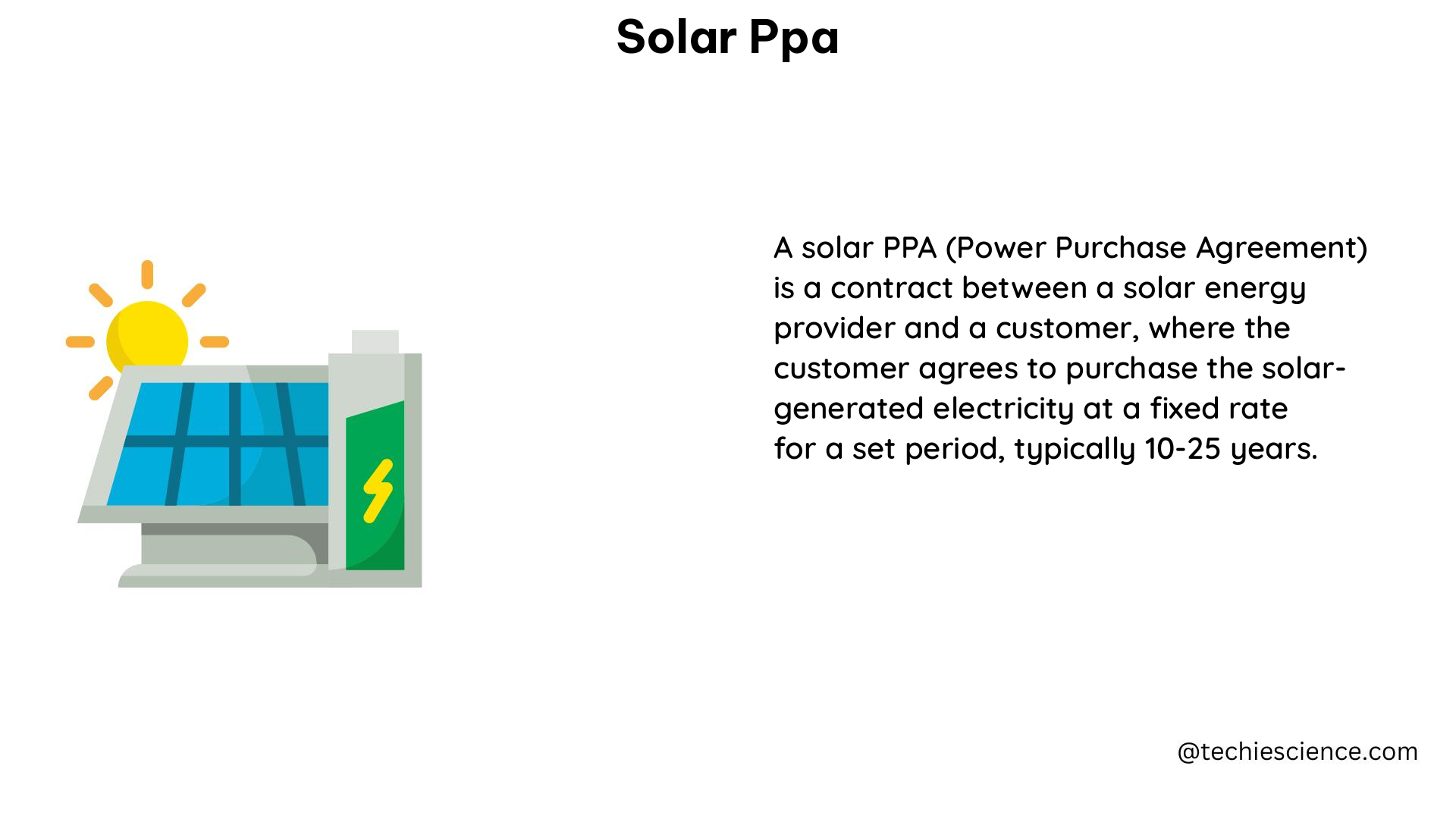Solar Power Purchase Agreements (PPAs) have become a popular financing mechanism for renewable energy projects, particularly in the solar industry. A solar PPA is a long-term contract between an energy buyer (often a commercial or industrial entity) and an energy producer (the solar asset owner) to purchase a specified amount of solar-generated electricity at an agreed-upon price over a set period, typically 10-20 years.
Understanding the Fundamentals of Solar PPAs
Key Components of a Solar PPA
- Project Details: The PPA should clearly define the solar project’s location, size (in kW or MW), technology (e.g., monocrystalline, polycrystalline, thin-film), and expected annual energy production (in kWh).
- PPA Term: The duration of the agreement, usually ranging from 10 to 20 years, during which the energy buyer agrees to purchase the solar-generated electricity.
- Pricing Structure: The PPA should specify the per-unit rate ($/kWh) for the solar electricity, which may include escalation clauses to account for inflation or other market factors.
- Payment Terms: The agreement should outline the payment schedule, methods, and any penalties for late or non-payment.
- Performance Guarantees: The PPA should include provisions for minimum energy generation guarantees and remedies for underperformance.
- Maintenance and Operations: The agreement should define the responsibilities for maintaining and operating the solar system, including any scheduled maintenance or repairs.
- Termination Conditions: The PPA should specify the circumstances under which the agreement can be terminated, such as force majeure events or material breaches of the contract.
Advantages of Solar PPAs
- No Upfront Costs: The solar asset owner (developer or investor) typically covers the initial capital expenditure for the solar system, allowing the energy buyer to avoid the high upfront costs associated with solar installations.
- Predictable Energy Costs: Solar PPAs provide long-term price stability, shielding the energy buyer from fluctuations in electricity market prices.
- Sustainability and Environmental Benefits: Solar PPAs enable organizations to reduce their carbon footprint and demonstrate their commitment to renewable energy and sustainability.
- Tax Incentives and Rebates: The solar asset owner can often take advantage of federal, state, and local tax credits, incentives, and rebates, which can be passed on to the energy buyer in the form of lower PPA rates.
Analyzing Solar PPA Trends and Market Data

National Solar PPA Trends
- Over the past decade, utility-scale solar PPA rates have declined from over $100/MWh to around $50/MWh in 2020, driven by the rapid cost reductions in solar technology.
- However, recent PPA pricing has been more stable, with smaller declines, as solar development costs begin to stabilize.
Regional and State-Level Solar PPA Trends
- Regional and state-level data show similar trends, with a general uptick in PPA rates, excluding the Northeast region.
- Factors such as solar resource availability, state-level incentives, and local electricity market conditions can influence regional PPA rate variations.
Relationship between Solar PPA Rates and Electricity Market Rates
- As solar development costs stabilize and potentially increase, understanding the relationship between PPA rates and market electricity rates will be crucial in appraising the fair market value of solar projects.
- Monitoring this relationship can help stakeholders make informed decisions about their renewable energy strategies and ensure the long-term viability of solar PPAs.
Measuring the Impact of Solar PPAs
Key Metrics for Evaluating Solar PPA Impact
- Energy Consumption: Track the amount of solar-generated electricity consumed, measured in kWh or MWh.
- Energy Cost Savings: Calculate the cost savings achieved by purchasing solar-generated electricity at the PPA rate compared to the prevailing market electricity rates.
- Carbon Emissions Reduction: Quantify the reduction in greenhouse gas emissions (in metric tons of CO2 equivalent) resulting from the use of solar energy.
- Renewable Energy Certificates (RECs): Monitor the generation and ownership of RECs, which can be used to demonstrate the organization’s commitment to renewable energy.
- Power Purchase Agreement (PPA) Metrics: Analyze the PPA terms, such as the contract duration, pricing structure, and performance guarantees, to assess the overall value and impact of the solar PPA.
By tracking these metrics, organizations can effectively measure and communicate the environmental, financial, and social impact of their solar PPA investments, demonstrating their commitment to sustainability and inspiring others to follow suit.
Conclusion
Solar Power Purchase Agreements (PPAs) have emerged as a versatile and cost-effective financing mechanism for renewable energy projects, particularly in the solar industry. By understanding the key components, advantages, and market trends of solar PPAs, as well as the metrics for measuring their impact, stakeholders can make informed decisions and optimize their renewable energy strategies. As the solar industry continues to evolve, staying up-to-date with the latest developments in solar PPA technology and market dynamics will be crucial for organizations seeking to reduce their carbon footprint and contribute to a more sustainable future.
References:
– How to Measure Your Renewable Energy Impact – LinkedIn
– PPA Sizing & The Value of Flexibility – Werner Trabesinger – LinkedIn
– What is a Solar PPA? – Pexapark
– Understanding Solar PPA Trends and Determining Fair Market Value–An Update – Novoco.com

The lambdageeks.com Core SME Team is a group of experienced subject matter experts from diverse scientific and technical fields including Physics, Chemistry, Technology,Electronics & Electrical Engineering, Automotive, Mechanical Engineering. Our team collaborates to create high-quality, well-researched articles on a wide range of science and technology topics for the lambdageeks.com website.
All Our Senior SME are having more than 7 Years of experience in the respective fields . They are either Working Industry Professionals or assocaited With different Universities. Refer Our Authors Page to get to know About our Core SMEs.